Management Accounting Concepts, Techniques & Application in Decision
VerifiedAdded on 2023/01/06
|18
|4484
|71
Report
AI Summary
This report provides a comprehensive analysis of management accounting concepts and techniques used for decision-making within a business context. It explores various management accounting systems, including cost accounting and inventory management, and examines different reporting methods such as budget reporting, accounts receivable aging, and job cost reports. The report also delves into techniques of cost analysis for preparing income statements, comparing marginal costing and absorption costing methods. Furthermore, it discusses the advantages and disadvantages of planning tools for budgetary control and compares how organizations adopt management accounting systems to respond to financial problems. The analysis is contextualized with examples, such as Innocent Drinks, to illustrate the practical application of these concepts in enhancing financial performance and strategic decision-making. Desklib offers this assignment solution and many other resources for students.
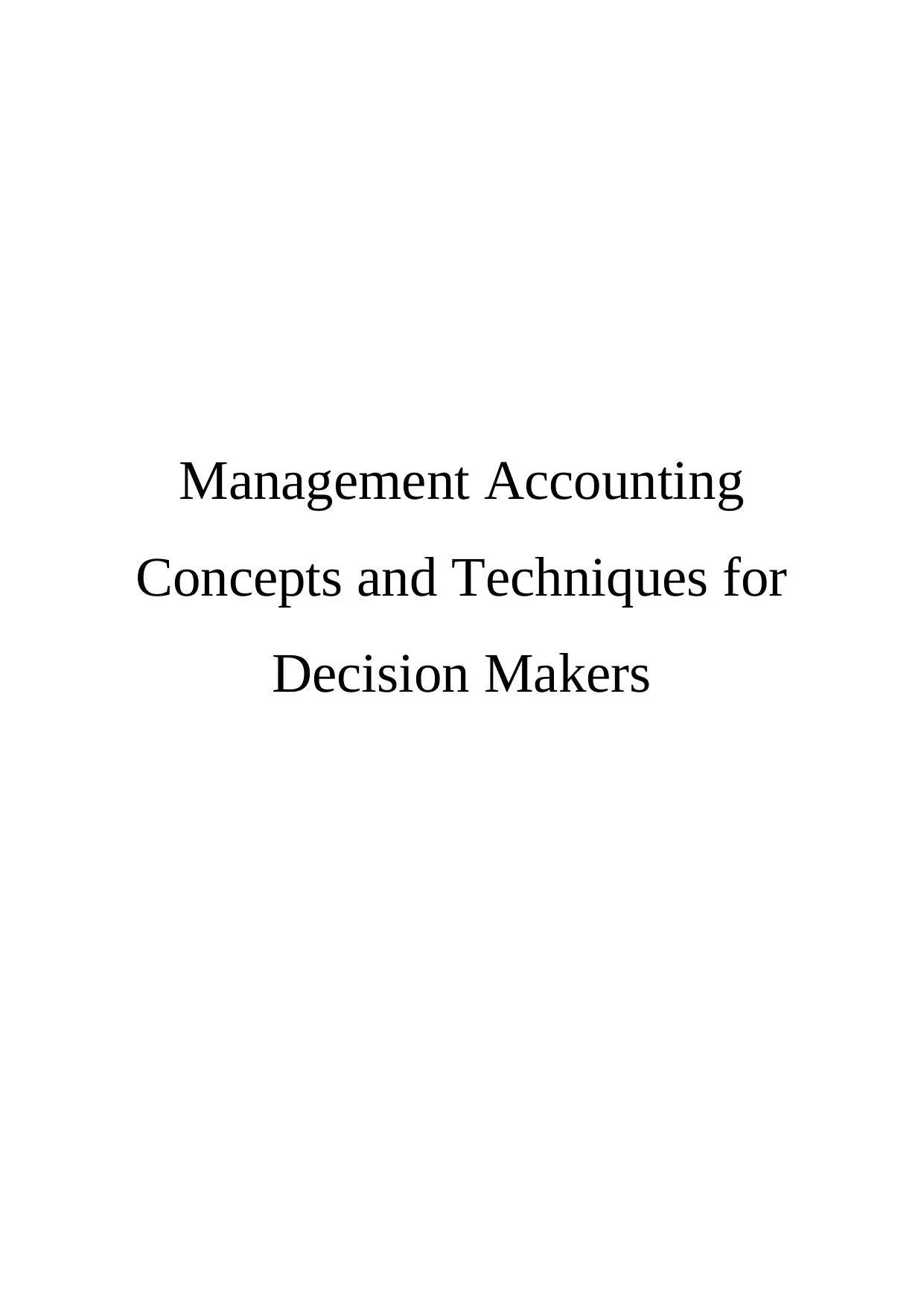
Management Accounting
Concepts and Techniques for
Decision Makers
Concepts and Techniques for
Decision Makers
Paraphrase This Document
Need a fresh take? Get an instant paraphrase of this document with our AI Paraphraser
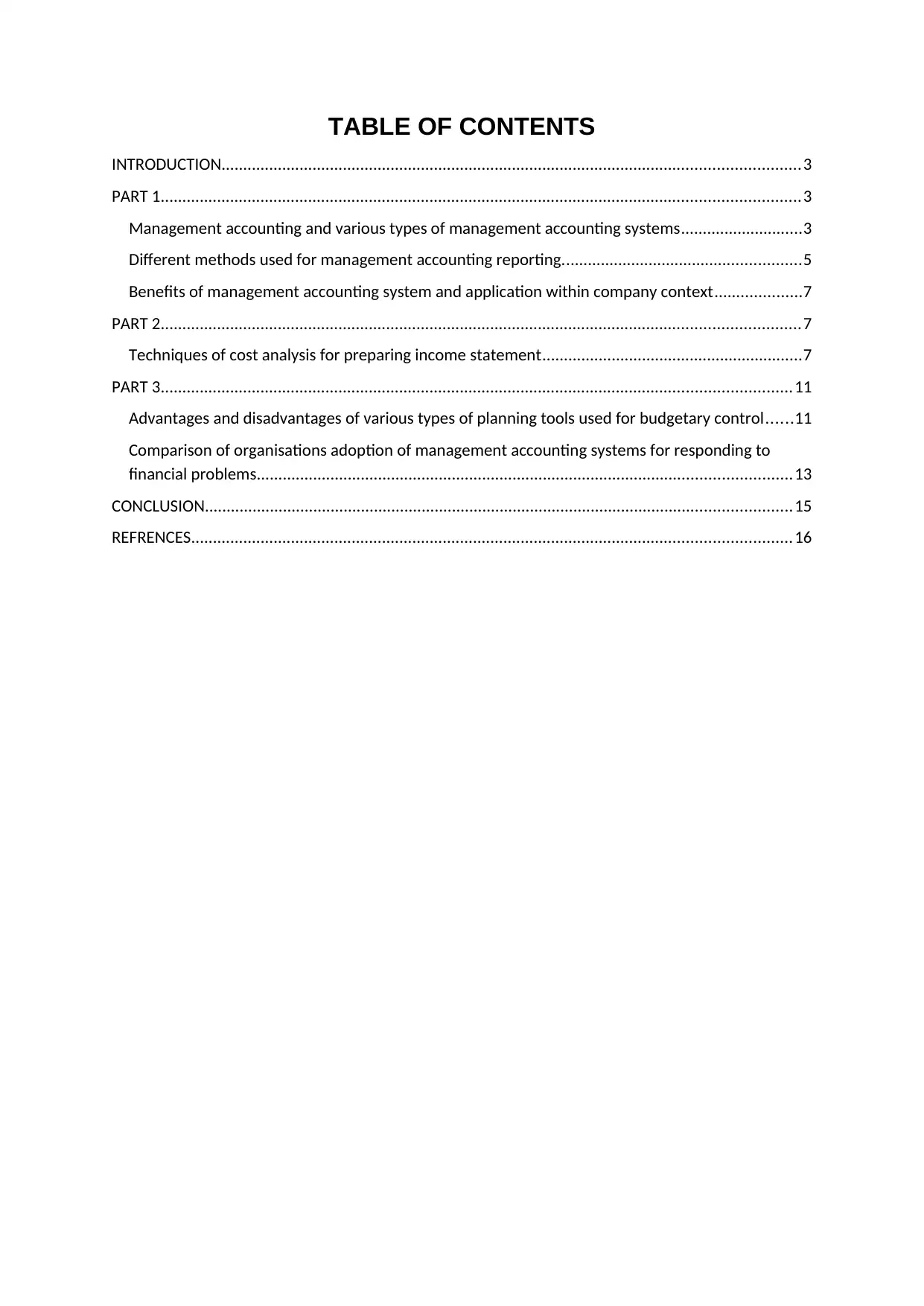
TABLE OF CONTENTS
INTRODUCTION.....................................................................................................................................3
PART 1...................................................................................................................................................3
Management accounting and various types of management accounting systems............................3
Different methods used for management accounting reporting.......................................................5
Benefits of management accounting system and application within company context....................7
PART 2...................................................................................................................................................7
Techniques of cost analysis for preparing income statement............................................................7
PART 3.................................................................................................................................................11
Advantages and disadvantages of various types of planning tools used for budgetary control......11
Comparison of organisations adoption of management accounting systems for responding to
financial problems...........................................................................................................................13
CONCLUSION.......................................................................................................................................15
REFRENCES..........................................................................................................................................16
INTRODUCTION.....................................................................................................................................3
PART 1...................................................................................................................................................3
Management accounting and various types of management accounting systems............................3
Different methods used for management accounting reporting.......................................................5
Benefits of management accounting system and application within company context....................7
PART 2...................................................................................................................................................7
Techniques of cost analysis for preparing income statement............................................................7
PART 3.................................................................................................................................................11
Advantages and disadvantages of various types of planning tools used for budgetary control......11
Comparison of organisations adoption of management accounting systems for responding to
financial problems...........................................................................................................................13
CONCLUSION.......................................................................................................................................15
REFRENCES..........................................................................................................................................16
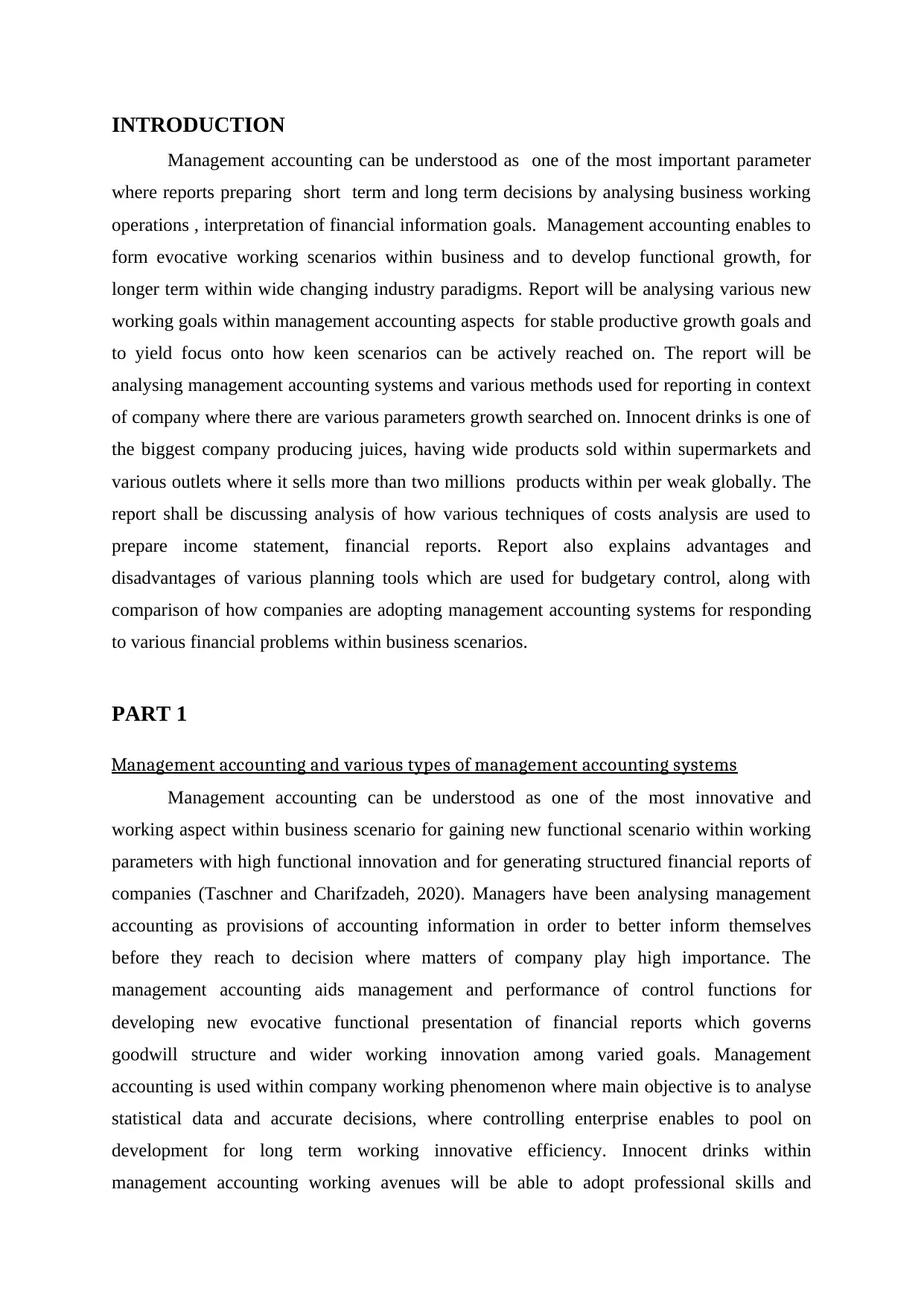
INTRODUCTION
Management accounting can be understood as one of the most important parameter
where reports preparing short term and long term decisions by analysing business working
operations , interpretation of financial information goals. Management accounting enables to
form evocative working scenarios within business and to develop functional growth, for
longer term within wide changing industry paradigms. Report will be analysing various new
working goals within management accounting aspects for stable productive growth goals and
to yield focus onto how keen scenarios can be actively reached on. The report will be
analysing management accounting systems and various methods used for reporting in context
of company where there are various parameters growth searched on. Innocent drinks is one of
the biggest company producing juices, having wide products sold within supermarkets and
various outlets where it sells more than two millions products within per weak globally. The
report shall be discussing analysis of how various techniques of costs analysis are used to
prepare income statement, financial reports. Report also explains advantages and
disadvantages of various planning tools which are used for budgetary control, along with
comparison of how companies are adopting management accounting systems for responding
to various financial problems within business scenarios.
PART 1
Management accounting and various types of management accounting systems
Management accounting can be understood as one of the most innovative and
working aspect within business scenario for gaining new functional scenario within working
parameters with high functional innovation and for generating structured financial reports of
companies (Taschner and Charifzadeh, 2020). Managers have been analysing management
accounting as provisions of accounting information in order to better inform themselves
before they reach to decision where matters of company play high importance. The
management accounting aids management and performance of control functions for
developing new evocative functional presentation of financial reports which governs
goodwill structure and wider working innovation among varied goals. Management
accounting is used within company working phenomenon where main objective is to analyse
statistical data and accurate decisions, where controlling enterprise enables to pool on
development for long term working innovative efficiency. Innocent drinks within
management accounting working avenues will be able to adopt professional skills and
Management accounting can be understood as one of the most important parameter
where reports preparing short term and long term decisions by analysing business working
operations , interpretation of financial information goals. Management accounting enables to
form evocative working scenarios within business and to develop functional growth, for
longer term within wide changing industry paradigms. Report will be analysing various new
working goals within management accounting aspects for stable productive growth goals and
to yield focus onto how keen scenarios can be actively reached on. The report will be
analysing management accounting systems and various methods used for reporting in context
of company where there are various parameters growth searched on. Innocent drinks is one of
the biggest company producing juices, having wide products sold within supermarkets and
various outlets where it sells more than two millions products within per weak globally. The
report shall be discussing analysis of how various techniques of costs analysis are used to
prepare income statement, financial reports. Report also explains advantages and
disadvantages of various planning tools which are used for budgetary control, along with
comparison of how companies are adopting management accounting systems for responding
to various financial problems within business scenarios.
PART 1
Management accounting and various types of management accounting systems
Management accounting can be understood as one of the most innovative and
working aspect within business scenario for gaining new functional scenario within working
parameters with high functional innovation and for generating structured financial reports of
companies (Taschner and Charifzadeh, 2020). Managers have been analysing management
accounting as provisions of accounting information in order to better inform themselves
before they reach to decision where matters of company play high importance. The
management accounting aids management and performance of control functions for
developing new evocative functional presentation of financial reports which governs
goodwill structure and wider working innovation among varied goals. Management
accounting is used within company working phenomenon where main objective is to analyse
statistical data and accurate decisions, where controlling enterprise enables to pool on
development for long term working innovative efficiency. Innocent drinks within
management accounting working avenues will be able to adopt professional skills and
⊘ This is a preview!⊘
Do you want full access?
Subscribe today to unlock all pages.

Trusted by 1+ million students worldwide
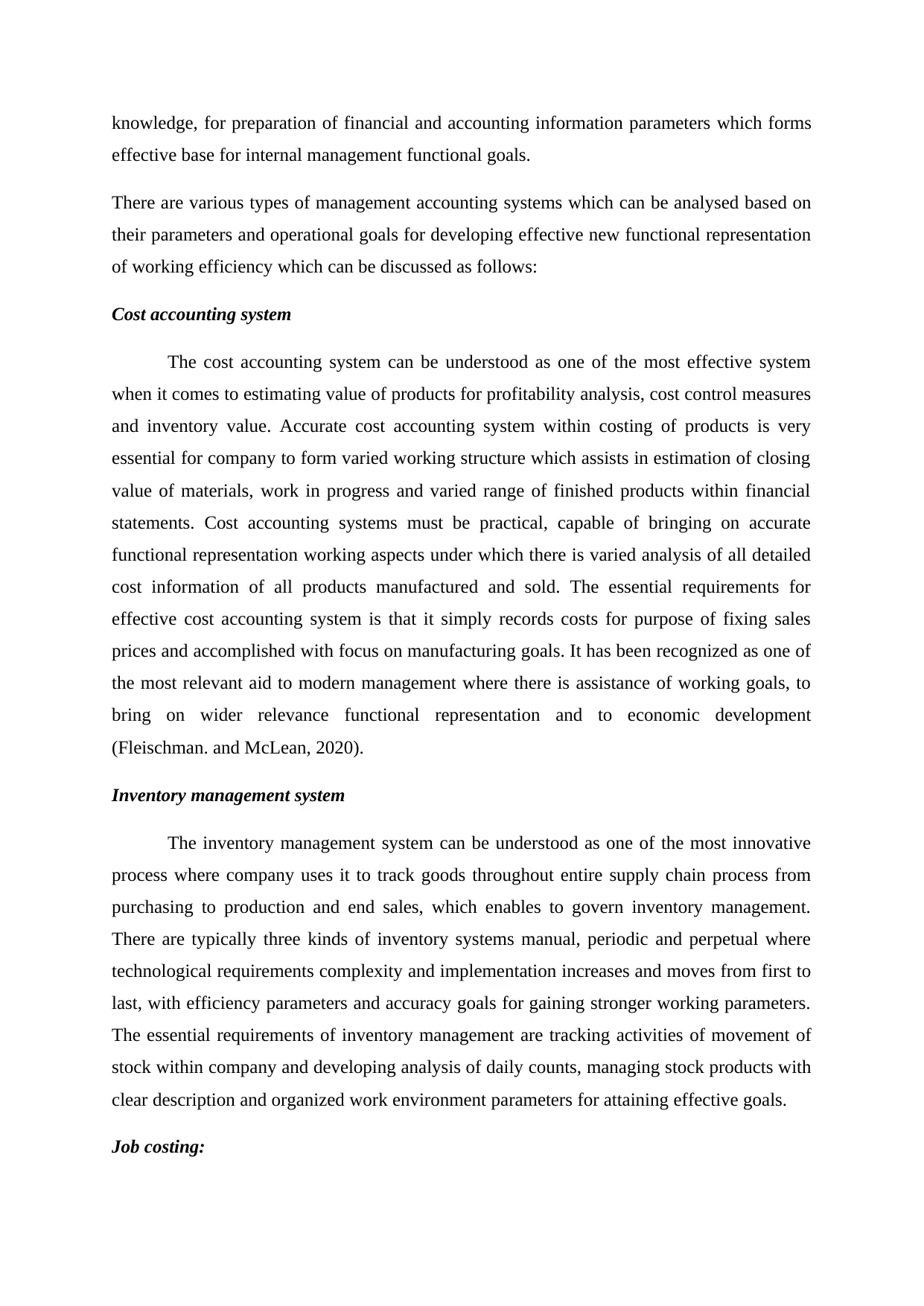
knowledge, for preparation of financial and accounting information parameters which forms
effective base for internal management functional goals.
There are various types of management accounting systems which can be analysed based on
their parameters and operational goals for developing effective new functional representation
of working efficiency which can be discussed as follows:
Cost accounting system
The cost accounting system can be understood as one of the most effective system
when it comes to estimating value of products for profitability analysis, cost control measures
and inventory value. Accurate cost accounting system within costing of products is very
essential for company to form varied working structure which assists in estimation of closing
value of materials, work in progress and varied range of finished products within financial
statements. Cost accounting systems must be practical, capable of bringing on accurate
functional representation working aspects under which there is varied analysis of all detailed
cost information of all products manufactured and sold. The essential requirements for
effective cost accounting system is that it simply records costs for purpose of fixing sales
prices and accomplished with focus on manufacturing goals. It has been recognized as one of
the most relevant aid to modern management where there is assistance of working goals, to
bring on wider relevance functional representation and to economic development
(Fleischman. and McLean, 2020).
Inventory management system
The inventory management system can be understood as one of the most innovative
process where company uses it to track goods throughout entire supply chain process from
purchasing to production and end sales, which enables to govern inventory management.
There are typically three kinds of inventory systems manual, periodic and perpetual where
technological requirements complexity and implementation increases and moves from first to
last, with efficiency parameters and accuracy goals for gaining stronger working parameters.
The essential requirements of inventory management are tracking activities of movement of
stock within company and developing analysis of daily counts, managing stock products with
clear description and organized work environment parameters for attaining effective goals.
Job costing:
effective base for internal management functional goals.
There are various types of management accounting systems which can be analysed based on
their parameters and operational goals for developing effective new functional representation
of working efficiency which can be discussed as follows:
Cost accounting system
The cost accounting system can be understood as one of the most effective system
when it comes to estimating value of products for profitability analysis, cost control measures
and inventory value. Accurate cost accounting system within costing of products is very
essential for company to form varied working structure which assists in estimation of closing
value of materials, work in progress and varied range of finished products within financial
statements. Cost accounting systems must be practical, capable of bringing on accurate
functional representation working aspects under which there is varied analysis of all detailed
cost information of all products manufactured and sold. The essential requirements for
effective cost accounting system is that it simply records costs for purpose of fixing sales
prices and accomplished with focus on manufacturing goals. It has been recognized as one of
the most relevant aid to modern management where there is assistance of working goals, to
bring on wider relevance functional representation and to economic development
(Fleischman. and McLean, 2020).
Inventory management system
The inventory management system can be understood as one of the most innovative
process where company uses it to track goods throughout entire supply chain process from
purchasing to production and end sales, which enables to govern inventory management.
There are typically three kinds of inventory systems manual, periodic and perpetual where
technological requirements complexity and implementation increases and moves from first to
last, with efficiency parameters and accuracy goals for gaining stronger working parameters.
The essential requirements of inventory management are tracking activities of movement of
stock within company and developing analysis of daily counts, managing stock products with
clear description and organized work environment parameters for attaining effective goals.
Job costing:
Paraphrase This Document
Need a fresh take? Get an instant paraphrase of this document with our AI Paraphraser
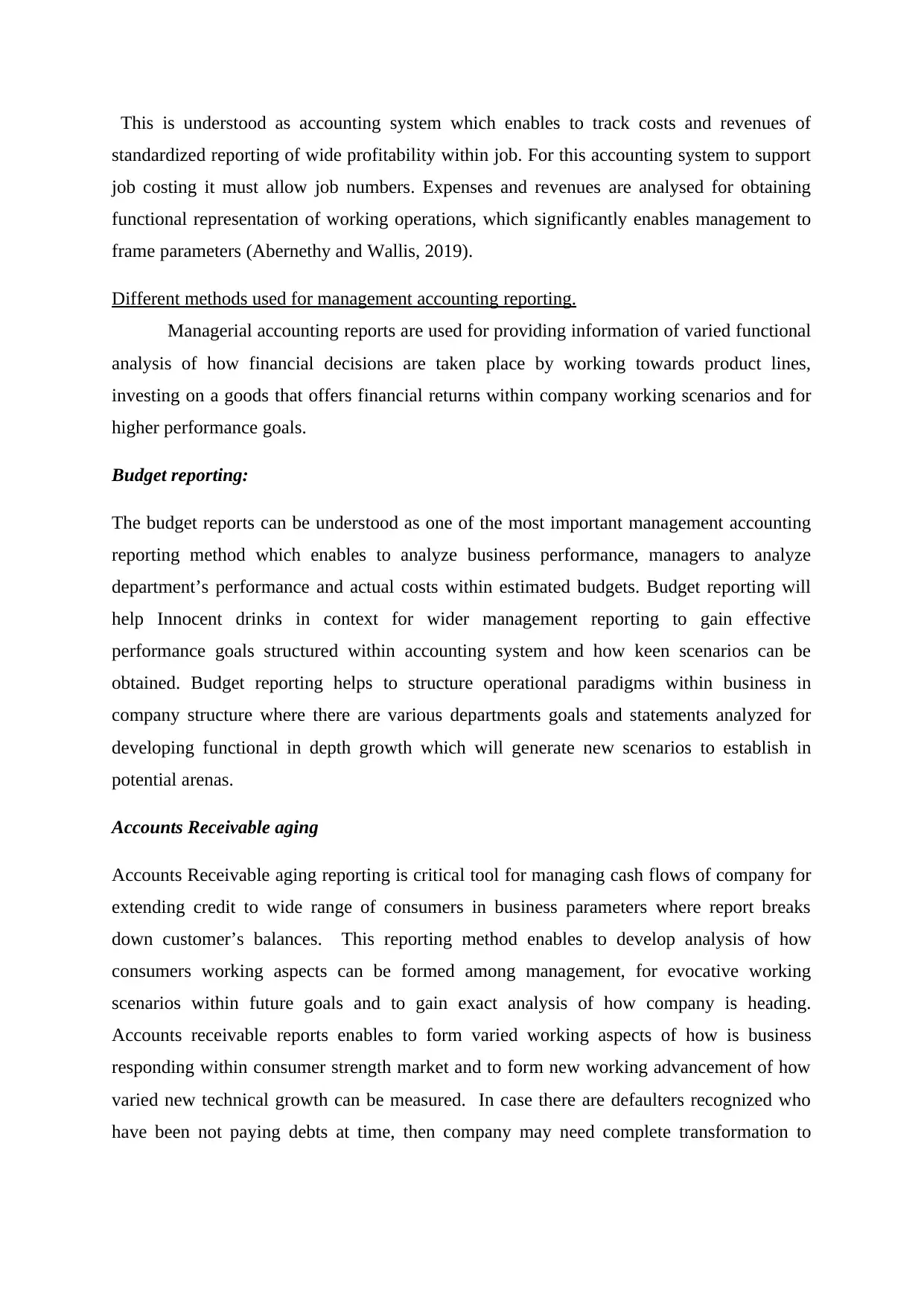
This is understood as accounting system which enables to track costs and revenues of
standardized reporting of wide profitability within job. For this accounting system to support
job costing it must allow job numbers. Expenses and revenues are analysed for obtaining
functional representation of working operations, which significantly enables management to
frame parameters (Abernethy and Wallis, 2019).
Different methods used for management accounting reporting.
Managerial accounting reports are used for providing information of varied functional
analysis of how financial decisions are taken place by working towards product lines,
investing on a goods that offers financial returns within company working scenarios and for
higher performance goals.
Budget reporting:
The budget reports can be understood as one of the most important management accounting
reporting method which enables to analyze business performance, managers to analyze
department’s performance and actual costs within estimated budgets. Budget reporting will
help Innocent drinks in context for wider management reporting to gain effective
performance goals structured within accounting system and how keen scenarios can be
obtained. Budget reporting helps to structure operational paradigms within business in
company structure where there are various departments goals and statements analyzed for
developing functional in depth growth which will generate new scenarios to establish in
potential arenas.
Accounts Receivable aging
Accounts Receivable aging reporting is critical tool for managing cash flows of company for
extending credit to wide range of consumers in business parameters where report breaks
down customer’s balances. This reporting method enables to develop analysis of how
consumers working aspects can be formed among management, for evocative working
scenarios within future goals and to gain exact analysis of how company is heading.
Accounts receivable reports enables to form varied working aspects of how is business
responding within consumer strength market and to form new working advancement of how
varied new technical growth can be measured. In case there are defaulters recognized who
have been not paying debts at time, then company may need complete transformation to
standardized reporting of wide profitability within job. For this accounting system to support
job costing it must allow job numbers. Expenses and revenues are analysed for obtaining
functional representation of working operations, which significantly enables management to
frame parameters (Abernethy and Wallis, 2019).
Different methods used for management accounting reporting.
Managerial accounting reports are used for providing information of varied functional
analysis of how financial decisions are taken place by working towards product lines,
investing on a goods that offers financial returns within company working scenarios and for
higher performance goals.
Budget reporting:
The budget reports can be understood as one of the most important management accounting
reporting method which enables to analyze business performance, managers to analyze
department’s performance and actual costs within estimated budgets. Budget reporting will
help Innocent drinks in context for wider management reporting to gain effective
performance goals structured within accounting system and how keen scenarios can be
obtained. Budget reporting helps to structure operational paradigms within business in
company structure where there are various departments goals and statements analyzed for
developing functional in depth growth which will generate new scenarios to establish in
potential arenas.
Accounts Receivable aging
Accounts Receivable aging reporting is critical tool for managing cash flows of company for
extending credit to wide range of consumers in business parameters where report breaks
down customer’s balances. This reporting method enables to develop analysis of how
consumers working aspects can be formed among management, for evocative working
scenarios within future goals and to gain exact analysis of how company is heading.
Accounts receivable reports enables to form varied working aspects of how is business
responding within consumer strength market and to form new working advancement of how
varied new technical growth can be measured. In case there are defaulters recognized who
have been not paying debts at time, then company may need complete transformation to

tighter credit policies as cash flow is critical for operation of business for gaining competitive
goodwill (Căpușneanu, Topor and Marin-Pantelescu, 2020).
Job cost reports
The job cost reports can be understood as specific project which are financed by small
businesses and are matched with estimates of revenue which can be evaluated based on jobs
profitability standards. Job cost reports play important role in estimating revenue within
business so that profitability can be measured by evaluating fundamentally where additional
efforts instead of wasting time and money on jobs can be put further. Job cost reports play
integral role in analyzing working expenses within projects so that progress in correct areas
of waste can be checked with regularity.
Inventory and manufacturing reports
This accounting report method is used within small businesses for producing products
and managerial accounting reports for making manufacturing accounting reports, where
identification of all inventory waste and labor costs can be done effectively. This report is
known for analysis overhead costs which later enable to compare parameters within busines
for highlighting arenas to improve best performing departments and to yield focus onto
various new governing scenarios. This method of reporting also develops functional growth
within inventory management and how various raw materials, operational programs are
effectively managed (Cescon, Costantini and Grassetti, 2019).
Performance reports
The performance reports are one of the most actively used within companies where
whole performances are analyzed from employees working scenarios till the whole working
scenarios which develop performance reports which are generally used for developing growth
goals. Managers within performance reports focus on making strategic key decisions where
future of company are analyzed to see varied functional aspects and performances where key
scenarios are also analyzed. Performance related managerial accounting reports also enable in
depth insight into working structure of company for gaining new relative functional aspects
which enable to develop functional performance to be formatted based on wider goals.
goodwill (Căpușneanu, Topor and Marin-Pantelescu, 2020).
Job cost reports
The job cost reports can be understood as specific project which are financed by small
businesses and are matched with estimates of revenue which can be evaluated based on jobs
profitability standards. Job cost reports play important role in estimating revenue within
business so that profitability can be measured by evaluating fundamentally where additional
efforts instead of wasting time and money on jobs can be put further. Job cost reports play
integral role in analyzing working expenses within projects so that progress in correct areas
of waste can be checked with regularity.
Inventory and manufacturing reports
This accounting report method is used within small businesses for producing products
and managerial accounting reports for making manufacturing accounting reports, where
identification of all inventory waste and labor costs can be done effectively. This report is
known for analysis overhead costs which later enable to compare parameters within busines
for highlighting arenas to improve best performing departments and to yield focus onto
various new governing scenarios. This method of reporting also develops functional growth
within inventory management and how various raw materials, operational programs are
effectively managed (Cescon, Costantini and Grassetti, 2019).
Performance reports
The performance reports are one of the most actively used within companies where
whole performances are analyzed from employees working scenarios till the whole working
scenarios which develop performance reports which are generally used for developing growth
goals. Managers within performance reports focus on making strategic key decisions where
future of company are analyzed to see varied functional aspects and performances where key
scenarios are also analyzed. Performance related managerial accounting reports also enable in
depth insight into working structure of company for gaining new relative functional aspects
which enable to develop functional performance to be formatted based on wider goals.
⊘ This is a preview!⊘
Do you want full access?
Subscribe today to unlock all pages.

Trusted by 1+ million students worldwide
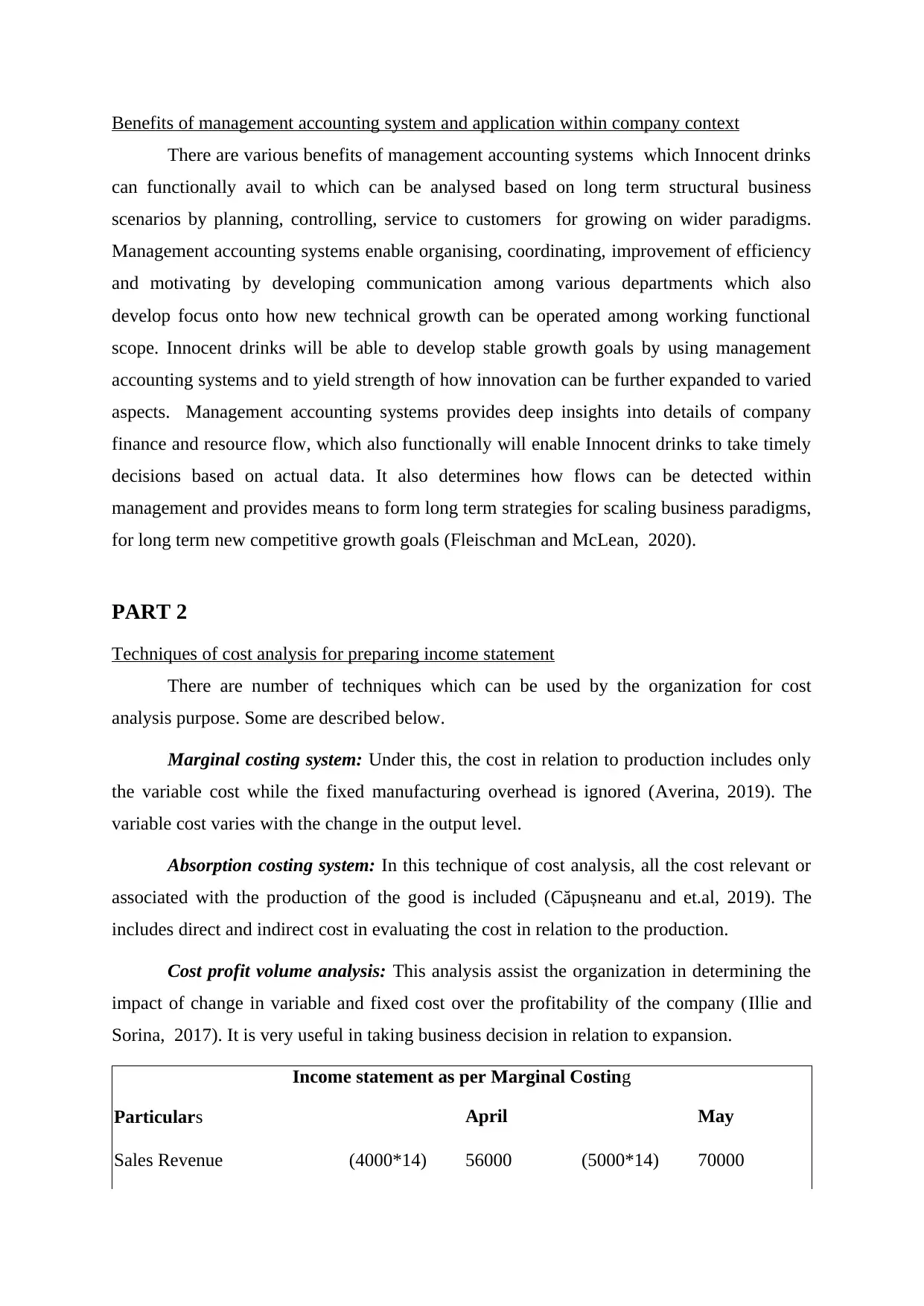
Benefits of management accounting system and application within company context
There are various benefits of management accounting systems which Innocent drinks
can functionally avail to which can be analysed based on long term structural business
scenarios by planning, controlling, service to customers for growing on wider paradigms.
Management accounting systems enable organising, coordinating, improvement of efficiency
and motivating by developing communication among various departments which also
develop focus onto how new technical growth can be operated among working functional
scope. Innocent drinks will be able to develop stable growth goals by using management
accounting systems and to yield strength of how innovation can be further expanded to varied
aspects. Management accounting systems provides deep insights into details of company
finance and resource flow, which also functionally will enable Innocent drinks to take timely
decisions based on actual data. It also determines how flows can be detected within
management and provides means to form long term strategies for scaling business paradigms,
for long term new competitive growth goals (Fleischman and McLean, 2020).
PART 2
Techniques of cost analysis for preparing income statement
There are number of techniques which can be used by the organization for cost
analysis purpose. Some are described below.
Marginal costing system: Under this, the cost in relation to production includes only
the variable cost while the fixed manufacturing overhead is ignored (Averina, 2019). The
variable cost varies with the change in the output level.
Absorption costing system: In this technique of cost analysis, all the cost relevant or
associated with the production of the good is included (Căpușneanu and et.al, 2019). The
includes direct and indirect cost in evaluating the cost in relation to the production.
Cost profit volume analysis: This analysis assist the organization in determining the
impact of change in variable and fixed cost over the profitability of the company (Illie and
Sorina, 2017). It is very useful in taking business decision in relation to expansion.
Income statement as per Marginal Costing
Particulars April May
Sales Revenue (4000*14) 56000 (5000*14) 70000
There are various benefits of management accounting systems which Innocent drinks
can functionally avail to which can be analysed based on long term structural business
scenarios by planning, controlling, service to customers for growing on wider paradigms.
Management accounting systems enable organising, coordinating, improvement of efficiency
and motivating by developing communication among various departments which also
develop focus onto how new technical growth can be operated among working functional
scope. Innocent drinks will be able to develop stable growth goals by using management
accounting systems and to yield strength of how innovation can be further expanded to varied
aspects. Management accounting systems provides deep insights into details of company
finance and resource flow, which also functionally will enable Innocent drinks to take timely
decisions based on actual data. It also determines how flows can be detected within
management and provides means to form long term strategies for scaling business paradigms,
for long term new competitive growth goals (Fleischman and McLean, 2020).
PART 2
Techniques of cost analysis for preparing income statement
There are number of techniques which can be used by the organization for cost
analysis purpose. Some are described below.
Marginal costing system: Under this, the cost in relation to production includes only
the variable cost while the fixed manufacturing overhead is ignored (Averina, 2019). The
variable cost varies with the change in the output level.
Absorption costing system: In this technique of cost analysis, all the cost relevant or
associated with the production of the good is included (Căpușneanu and et.al, 2019). The
includes direct and indirect cost in evaluating the cost in relation to the production.
Cost profit volume analysis: This analysis assist the organization in determining the
impact of change in variable and fixed cost over the profitability of the company (Illie and
Sorina, 2017). It is very useful in taking business decision in relation to expansion.
Income statement as per Marginal Costing
Particulars April May
Sales Revenue (4000*14) 56000 (5000*14) 70000
Paraphrase This Document
Need a fresh take? Get an instant paraphrase of this document with our AI Paraphraser
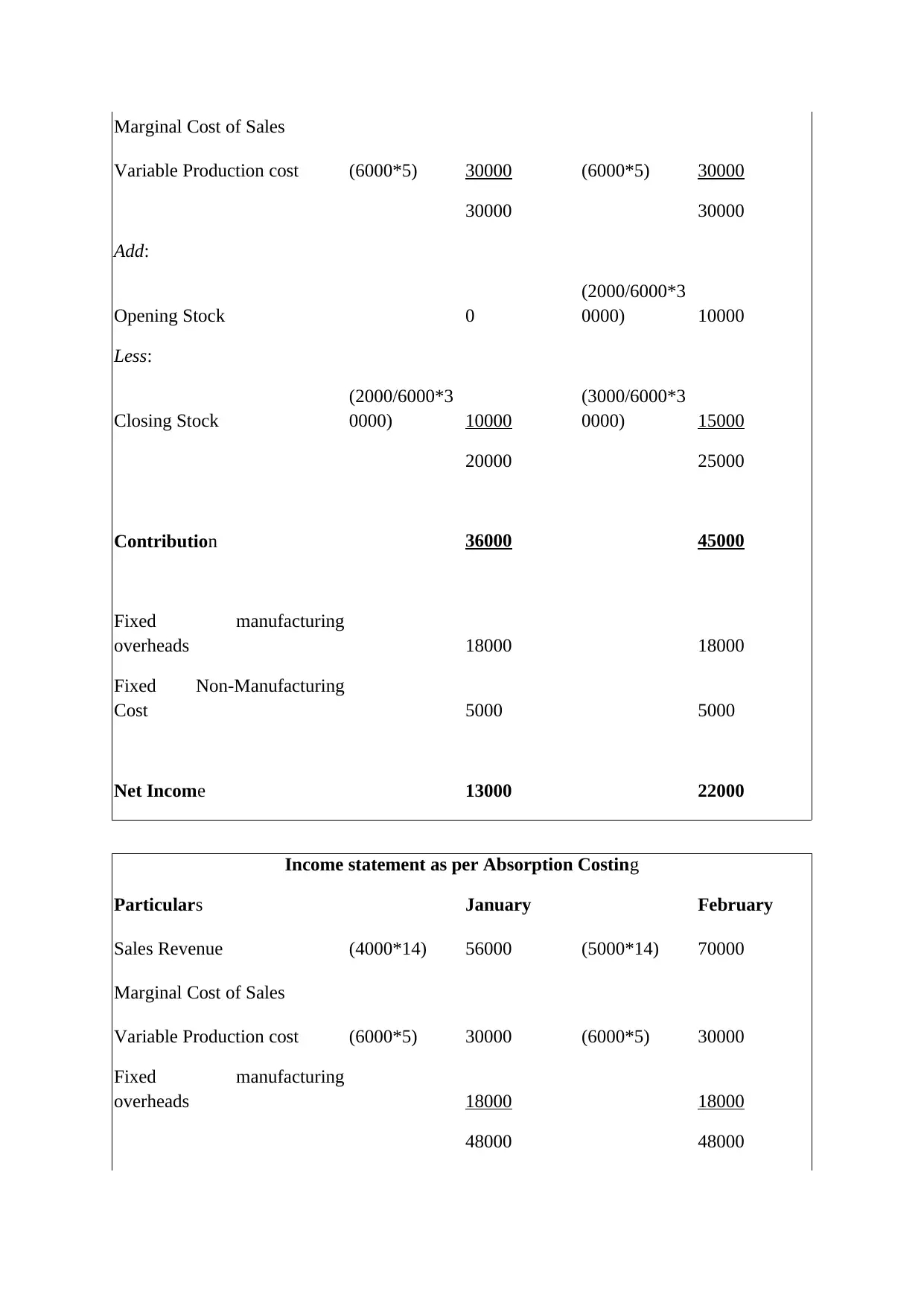
Marginal Cost of Sales
Variable Production cost (6000*5) 30000 (6000*5) 30000
30000 30000
Add:
Opening Stock 0
(2000/6000*3
0000) 10000
Less:
Closing Stock
(2000/6000*3
0000) 10000
(3000/6000*3
0000) 15000
20000 25000
Contribution 36000 45000
Fixed manufacturing
overheads 18000 18000
Fixed Non-Manufacturing
Cost 5000 5000
Net Income 13000 22000
Income statement as per Absorption Costing
Particulars January February
Sales Revenue (4000*14) 56000 (5000*14) 70000
Marginal Cost of Sales
Variable Production cost (6000*5) 30000 (6000*5) 30000
Fixed manufacturing
overheads 18000 18000
48000 48000
Variable Production cost (6000*5) 30000 (6000*5) 30000
30000 30000
Add:
Opening Stock 0
(2000/6000*3
0000) 10000
Less:
Closing Stock
(2000/6000*3
0000) 10000
(3000/6000*3
0000) 15000
20000 25000
Contribution 36000 45000
Fixed manufacturing
overheads 18000 18000
Fixed Non-Manufacturing
Cost 5000 5000
Net Income 13000 22000
Income statement as per Absorption Costing
Particulars January February
Sales Revenue (4000*14) 56000 (5000*14) 70000
Marginal Cost of Sales
Variable Production cost (6000*5) 30000 (6000*5) 30000
Fixed manufacturing
overheads 18000 18000
48000 48000
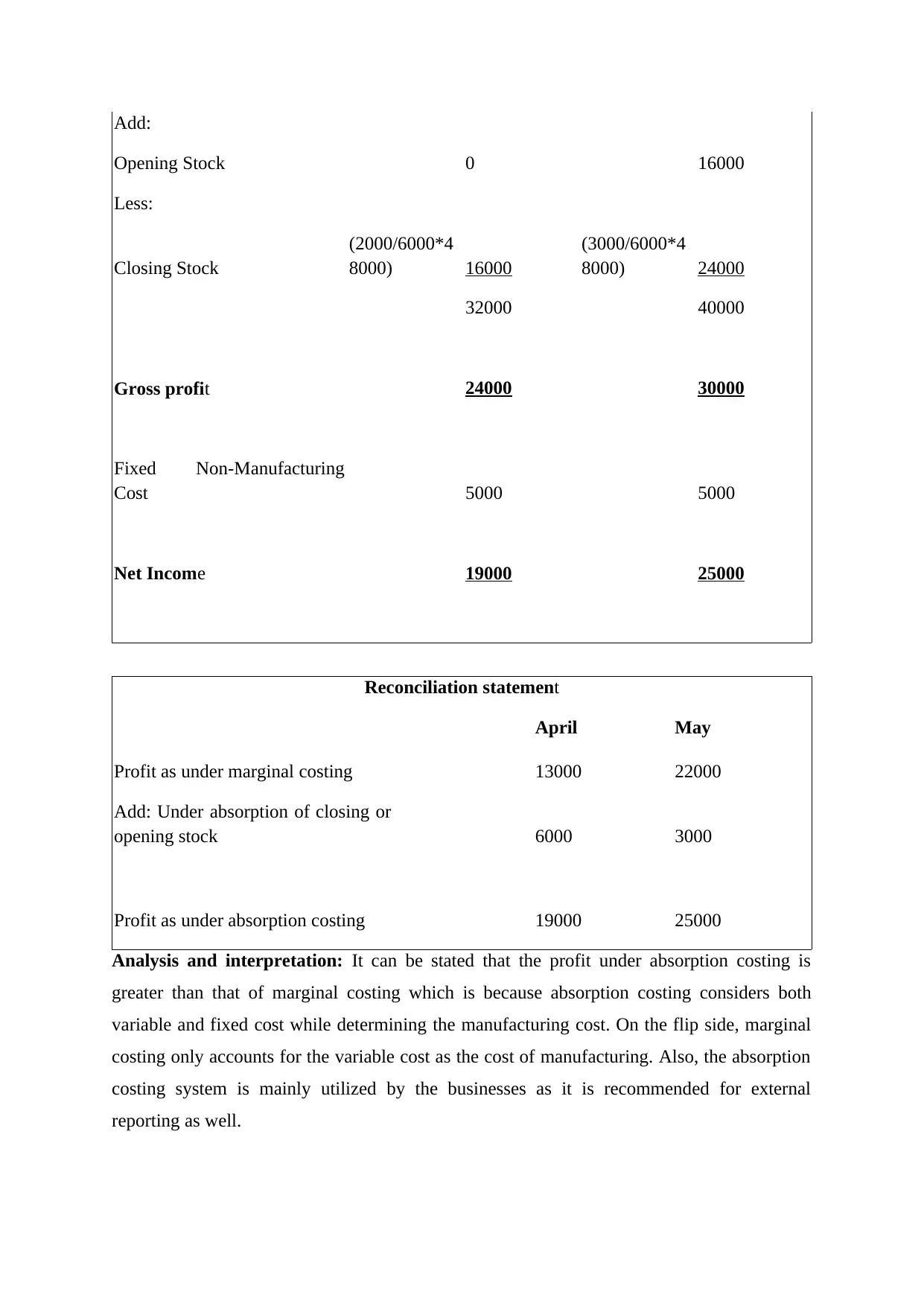
Add:
Opening Stock 0 16000
Less:
Closing Stock
(2000/6000*4
8000) 16000
(3000/6000*4
8000) 24000
32000 40000
Gross profit 24000 30000
Fixed Non-Manufacturing
Cost 5000 5000
Net Income 19000 25000
Reconciliation statement
April May
Profit as under marginal costing 13000 22000
Add: Under absorption of closing or
opening stock 6000 3000
Profit as under absorption costing 19000 25000
Analysis and interpretation: It can be stated that the profit under absorption costing is
greater than that of marginal costing which is because absorption costing considers both
variable and fixed cost while determining the manufacturing cost. On the flip side, marginal
costing only accounts for the variable cost as the cost of manufacturing. Also, the absorption
costing system is mainly utilized by the businesses as it is recommended for external
reporting as well.
Opening Stock 0 16000
Less:
Closing Stock
(2000/6000*4
8000) 16000
(3000/6000*4
8000) 24000
32000 40000
Gross profit 24000 30000
Fixed Non-Manufacturing
Cost 5000 5000
Net Income 19000 25000
Reconciliation statement
April May
Profit as under marginal costing 13000 22000
Add: Under absorption of closing or
opening stock 6000 3000
Profit as under absorption costing 19000 25000
Analysis and interpretation: It can be stated that the profit under absorption costing is
greater than that of marginal costing which is because absorption costing considers both
variable and fixed cost while determining the manufacturing cost. On the flip side, marginal
costing only accounts for the variable cost as the cost of manufacturing. Also, the absorption
costing system is mainly utilized by the businesses as it is recommended for external
reporting as well.
⊘ This is a preview!⊘
Do you want full access?
Subscribe today to unlock all pages.

Trusted by 1+ million students worldwide
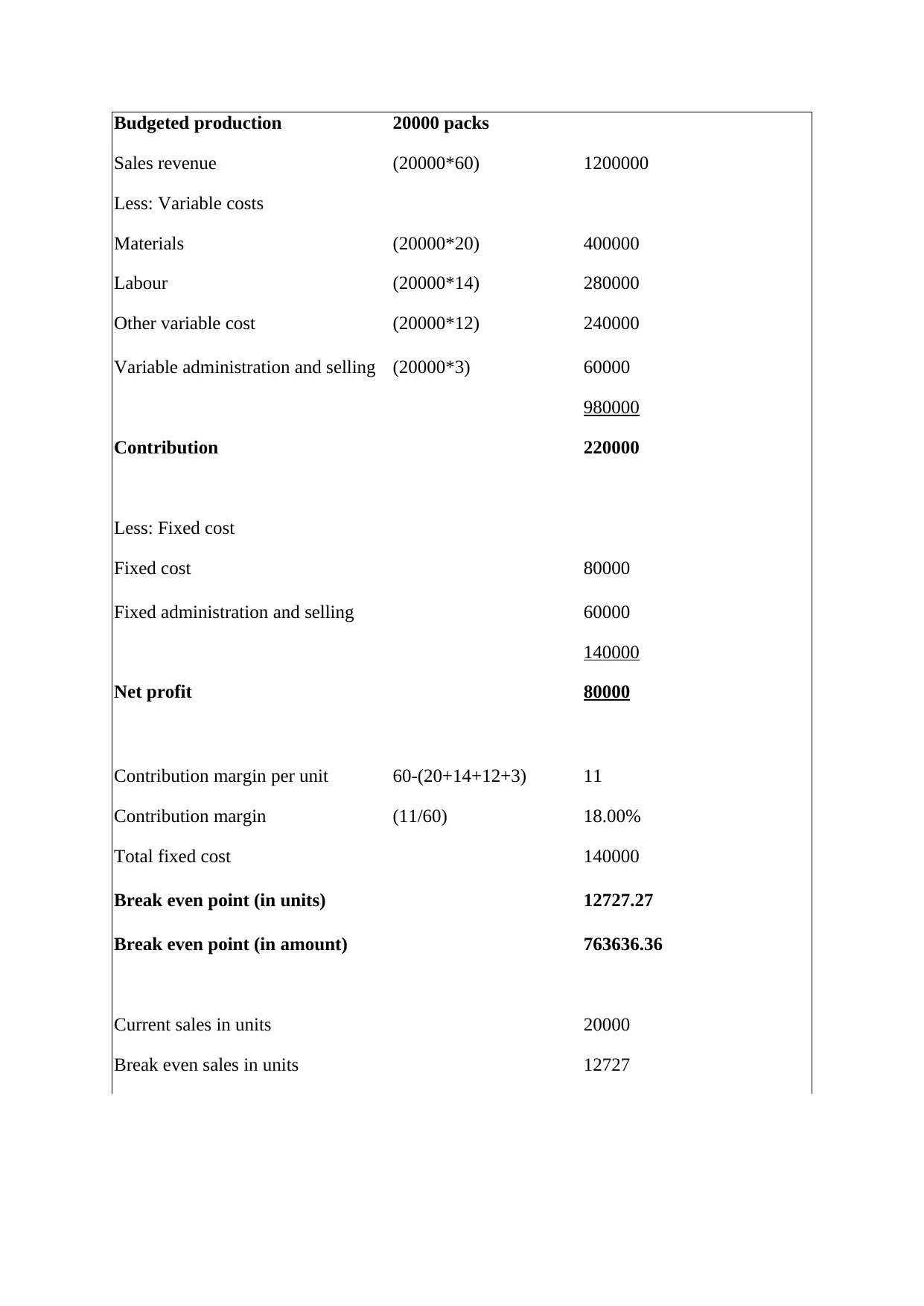
Budgeted production 20000 packs
Sales revenue (20000*60) 1200000
Less: Variable costs
Materials (20000*20) 400000
Labour (20000*14) 280000
Other variable cost (20000*12) 240000
Variable administration and selling (20000*3) 60000
980000
Contribution 220000
Less: Fixed cost
Fixed cost 80000
Fixed administration and selling 60000
140000
Net profit 80000
Contribution margin per unit 60-(20+14+12+3) 11
Contribution margin (11/60) 18.00%
Total fixed cost 140000
Break even point (in units) 12727.27
Break even point (in amount) 763636.36
Current sales in units 20000
Break even sales in units 12727
Sales revenue (20000*60) 1200000
Less: Variable costs
Materials (20000*20) 400000
Labour (20000*14) 280000
Other variable cost (20000*12) 240000
Variable administration and selling (20000*3) 60000
980000
Contribution 220000
Less: Fixed cost
Fixed cost 80000
Fixed administration and selling 60000
140000
Net profit 80000
Contribution margin per unit 60-(20+14+12+3) 11
Contribution margin (11/60) 18.00%
Total fixed cost 140000
Break even point (in units) 12727.27
Break even point (in amount) 763636.36
Current sales in units 20000
Break even sales in units 12727
Paraphrase This Document
Need a fresh take? Get an instant paraphrase of this document with our AI Paraphraser
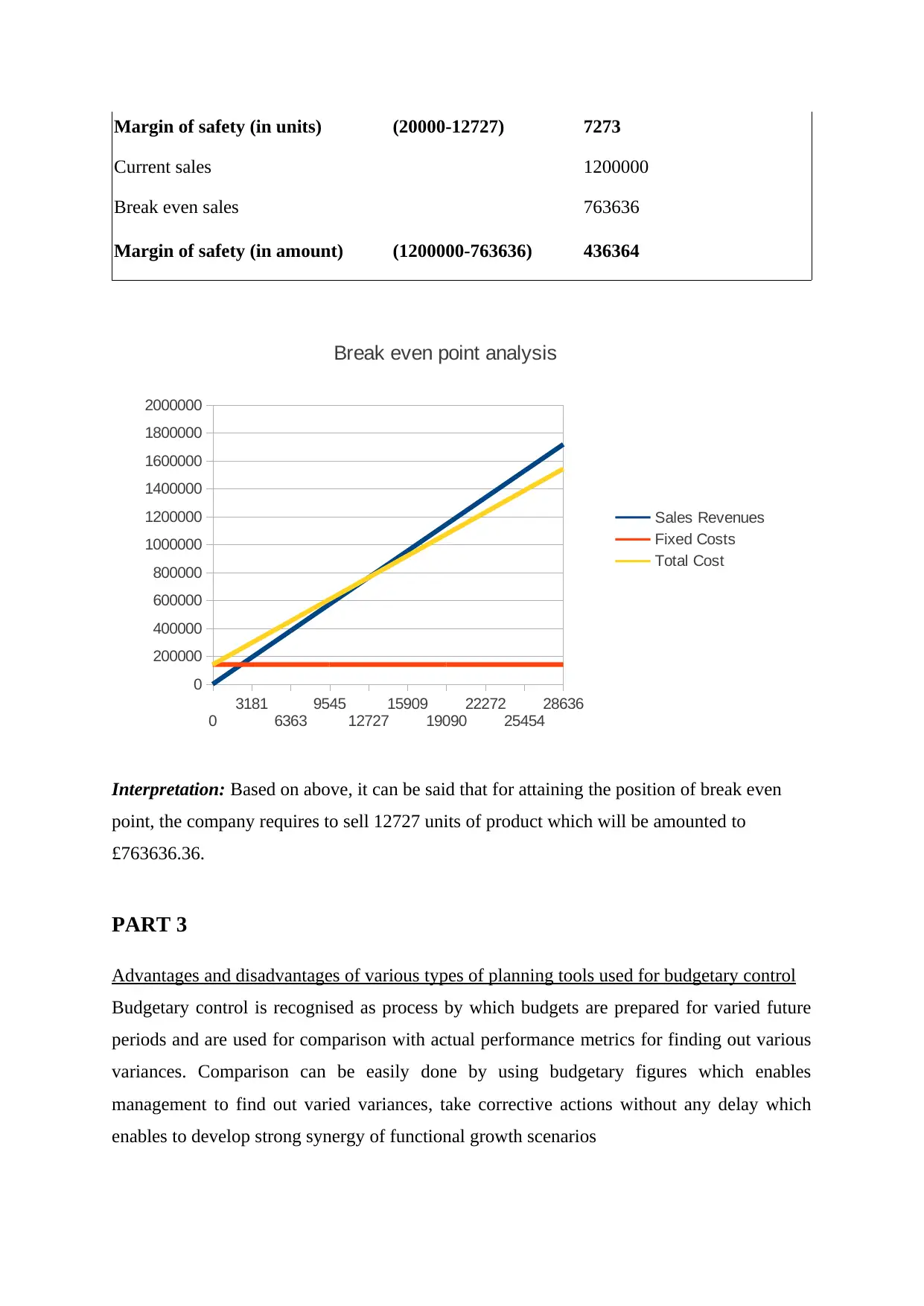
Margin of safety (in units) (20000-12727) 7273
Current sales 1200000
Break even sales 763636
Margin of safety (in amount) (1200000-763636) 436364
0
3181
6363
9545
12727
15909
19090
22272
25454
28636
0
200000
400000
600000
800000
1000000
1200000
1400000
1600000
1800000
2000000
Break even point analysis
Sales Revenues
Fixed Costs
Total Cost
Interpretation: Based on above, it can be said that for attaining the position of break even
point, the company requires to sell 12727 units of product which will be amounted to
£763636.36.
PART 3
Advantages and disadvantages of various types of planning tools used for budgetary control
Budgetary control is recognised as process by which budgets are prepared for varied future
periods and are used for comparison with actual performance metrics for finding out various
variances. Comparison can be easily done by using budgetary figures which enables
management to find out varied variances, take corrective actions without any delay which
enables to develop strong synergy of functional growth scenarios
Current sales 1200000
Break even sales 763636
Margin of safety (in amount) (1200000-763636) 436364
0
3181
6363
9545
12727
15909
19090
22272
25454
28636
0
200000
400000
600000
800000
1000000
1200000
1400000
1600000
1800000
2000000
Break even point analysis
Sales Revenues
Fixed Costs
Total Cost
Interpretation: Based on above, it can be said that for attaining the position of break even
point, the company requires to sell 12727 units of product which will be amounted to
£763636.36.
PART 3
Advantages and disadvantages of various types of planning tools used for budgetary control
Budgetary control is recognised as process by which budgets are prepared for varied future
periods and are used for comparison with actual performance metrics for finding out various
variances. Comparison can be easily done by using budgetary figures which enables
management to find out varied variances, take corrective actions without any delay which
enables to develop strong synergy of functional growth scenarios

To ensure structural planning within future for setting up budgets and requirements
for wider expected performance metrics which enables enterprise to anticipate future
growth goals and operate costs within departments with efficiency.
To eliminate wastes and anticipate capital expenditure within business which enables
to increase profitability by also centralizing control system , where top management is
able to yield focus on how varied growth operations can be reached on.
There are various types of planning tools used for budgetary control which enables to form
wide functional presentation of how various financial information can be analysed to develop
accurate budgetary control information which are widely different and dynamically shifting
from time to time. . Planning tools used within budgetary control enable companies to reach
at formed functional objectives which can be understood as follows (Jakobsen, Mitchell, and
Trenca, 2019).
Cost volume profit analysis: The cost volume profit analysis can be understood as one of the
major accounting procedure tool used for developing analysing focus how sales volume and
product costs on operating profits within business are correlated. The cost volume also
functionally holds assumption that all costs can be classified as fixed or variable which are
constant and units are produced for selling effectively. This is used by management as one of
the most important planning tool for estimating business revenue standards from sales, costs
and profits by operating advanced mathematical tools and working advancement to reach on
desired results. Innocent drinks will be able to develop to determine breakeven points in
business formats where this point enables us to analyse working parameters of new reflected
growth goals and at what points innovation can be built on by bringing on wider scenarios
productively.
Advantages: Ease of calculations with use of set standards, formulas and numbers
which changes quickly based on working paradigms and planning by analysing the
break even points helps managers to estimate working future spending objectives of
business. This has also been recognised to enable managers for deciding prices of
products with highest and lowest prices that offer various opportunities within
business and budget preparation parameters for gaining scope onto how new goals
will be formed.
for wider expected performance metrics which enables enterprise to anticipate future
growth goals and operate costs within departments with efficiency.
To eliminate wastes and anticipate capital expenditure within business which enables
to increase profitability by also centralizing control system , where top management is
able to yield focus on how varied growth operations can be reached on.
There are various types of planning tools used for budgetary control which enables to form
wide functional presentation of how various financial information can be analysed to develop
accurate budgetary control information which are widely different and dynamically shifting
from time to time. . Planning tools used within budgetary control enable companies to reach
at formed functional objectives which can be understood as follows (Jakobsen, Mitchell, and
Trenca, 2019).
Cost volume profit analysis: The cost volume profit analysis can be understood as one of the
major accounting procedure tool used for developing analysing focus how sales volume and
product costs on operating profits within business are correlated. The cost volume also
functionally holds assumption that all costs can be classified as fixed or variable which are
constant and units are produced for selling effectively. This is used by management as one of
the most important planning tool for estimating business revenue standards from sales, costs
and profits by operating advanced mathematical tools and working advancement to reach on
desired results. Innocent drinks will be able to develop to determine breakeven points in
business formats where this point enables us to analyse working parameters of new reflected
growth goals and at what points innovation can be built on by bringing on wider scenarios
productively.
Advantages: Ease of calculations with use of set standards, formulas and numbers
which changes quickly based on working paradigms and planning by analysing the
break even points helps managers to estimate working future spending objectives of
business. This has also been recognised to enable managers for deciding prices of
products with highest and lowest prices that offer various opportunities within
business and budget preparation parameters for gaining scope onto how new goals
will be formed.
⊘ This is a preview!⊘
Do you want full access?
Subscribe today to unlock all pages.

Trusted by 1+ million students worldwide
1 out of 18
Related Documents
Your All-in-One AI-Powered Toolkit for Academic Success.
+13062052269
info@desklib.com
Available 24*7 on WhatsApp / Email
![[object Object]](/_next/static/media/star-bottom.7253800d.svg)
Unlock your academic potential
Copyright © 2020–2025 A2Z Services. All Rights Reserved. Developed and managed by ZUCOL.





